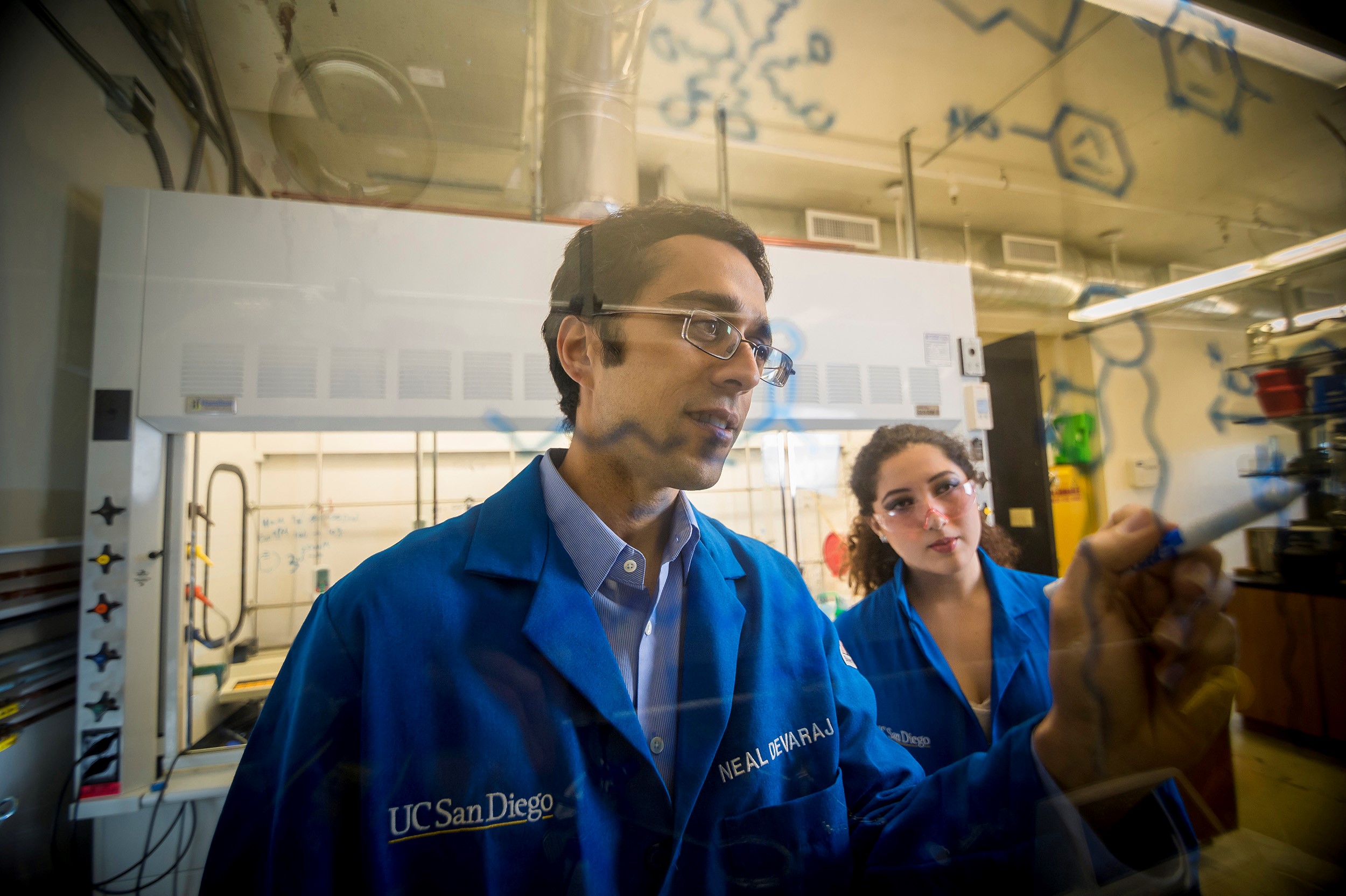
Neal K. Devaraj (left) and Natalya Ballard (right). Credit: Erik Jepsen, UC San Diego
The ability to develop artificial membranes that mimic complex living cells can provide insight into the building blocks of life and pave the way for scientists to someday create a slew of artificial systems, including artificial blood, immune cells and organelles, that could ultimately help treat diseases.
A research team led by Neal Devaraj, PhD, a professor of chemistry and biochemistry at the University of California, San Diego was the first to synthesize an artificial cell membrane that sustains continual growth, just like a living cell.
“We created an artificial membrane and we’ve been using that to study synthetic cells, materials that mimic the function and form of cells,” Devaraj said in an exclusive interview with R&D Magazine. “From a knowledge perspective, we can get closer to answering one of the ultimate scientific questions: what is life? A cell is extraordinarily complex, it has so many different molecules and it is all coming together and working. It would be interesting to understand how that comes about and to try to build a synthetic cell from the bottom up. Doing so is going to greatly improve our understanding.”
In the short-term, Devaraj explained that the synthetic membranes could be used to develop drug-filled liposomes that serve as drug delivery systems.
Devaraj said there are more ambitious long-term goals for his work with artificial membranes.
“One of the long-term, big ideas would be, can we actually create life in the lab and could we then start synthesizing cells that mimic the function and maybe go beyond the function of currently useful living cells like red blood cells and immune cells,” he said. “I think to do so we will need to have a better understanding of the interface between living and non-living materials.”
Devaraj, the 2018 Blavatnik National Chemistry Laureate, explained how the innovation resulted from his interest in better understanding how non-living matter, like organic molecules, can assemble to form life.
“I got really fascinated as a chemist by this question of what is the transition between non-living matter and living matter,” he said. “To put it another way, when does chemistry become biology? We thought it was important to start some experiments and at least try to get into this area. So I became interested in thinking about pursuing work chemically generating lipid membranes.”
Devaraj’s group wanted to reveal some of the fundamental chemical principles that lead to the origin of life and use that understanding to study membrane’s localized structures and processes.
He said initially they wanted to separate the two hydrocarbon chains of a phospholipid, one of the main components of a membrane and then chemically couple them back together.
“A very simple idea was to split the phospholipid into two single chains and use chemical reactions to join them back up together,” he said. “We basically take single chains and couple them together and make your two-tailed, two-chained phospholipid and that leads to membrane formation.”
To develop the growing membrane made from lipids, the researchers substituted a complex network of biochemical pathways used in nature with a single autocatalyst that simultaneously drives membrane growth.
The researchers eventually created hybrid synthetic membranes composed of several biological components that can perform functions like gene expression. The membranes mimic several features of complex living organisms, including the ability to adapt their composition in response to environmental cues.
Impact of this research
Already this research has resulted in new knowledge about how lipids affect various diseases.
“We’ve been learning a lot about how to manipulate lipids and how lipids react with one another,” Devaraj said. “Stepping back a little bit we see that lipid dysregulation is very important in diseases like atherosclerosis and diabetes. So we have been using the understanding we developed from our artificial membrane project and applying that understanding to lipid dysregulation.”
He also explained several questions the lab is working to answer in the near future.
“We are starting to integrate more with proteins, so the questions is can we start integrating with DNA?” Devaraj said. “Can we start mimicking higher order functions, so we can get our vesicles to predictively and robustly divide?”



